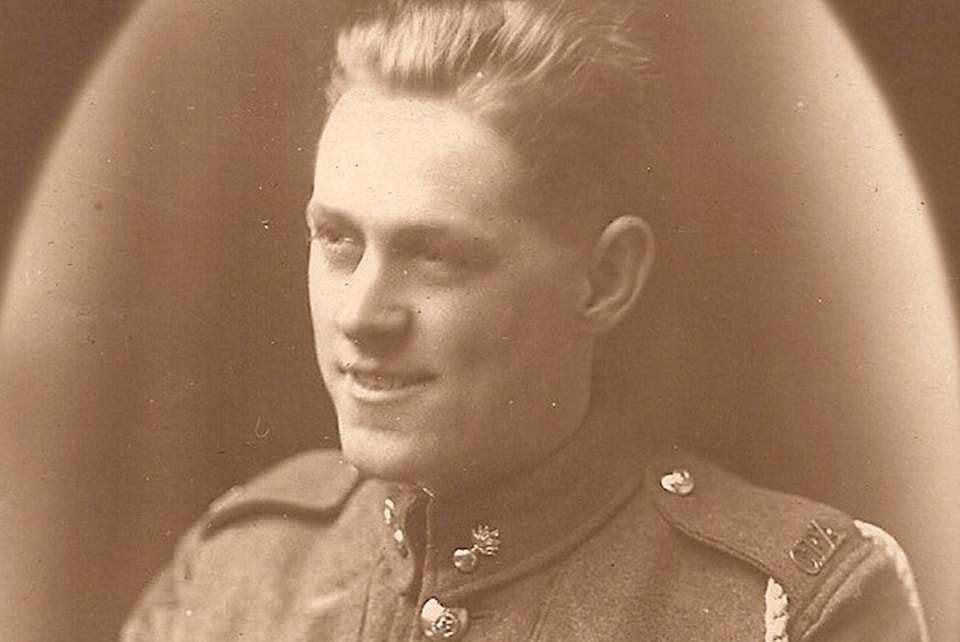ERIN LINN MCMULLAN
Special to the Westerly
As the wind whips up across Monks’ Point, Stephanie Ann Warner is sharing vintage photographs circa WWI on her laptop in the bright sunshine on the lawn outside her uncle Harold Frank Monks’ former home.
In sports clothes, she is perched on the edge of her chair, ready for a weekend on Vargas Island, where she will continue researching the Vargas ranchers’ history and her grandfather’s for the Harold Monks Project.
It was visiting here as a child that she first perused the photo albums and records that would eventually spark this passion project.
Her face now lit up, as it was last night, on her birthday, when she donned era-specific costume to deliver a talk on Vargas Island Ranchers at home and at war at the Legion.
Her talk kicked off the arrival of the traveling exhibit British Columbia’s War 1914-1918, along with her complimentary Vargas-focused installation downstairs at Tofino Clayoquot Heritage Museum.
“Thirteen of us enlisted and none of us went back,” Harold Monks said in an early 1970s interview. “Hovelaque was the only one left. He never went, he was too old. He stayed there. Some were killed…the others all scattered.”
Pierre Hovelaque and Frank Garrard were the original developers of this ranching community, pre-empting 1,280 acres and advertising in England, attracting settlers from as far away as New Zealand.
But, far from ‘gormless Englishman’ lured by claims of ‘easy clearing’ they included experienced farmers such as a group who had originally settled in Saskatchewan.
Monks, Warner surmises, came west for the opportunity.
On this remote island in Canada he could own land and fish—a life he could only dream of in Industrial England. From Monks’ beatific smile as photographed in his dugout canoe it is clear this Lancashire accountant had discovered Nirvana.
Warner, with a Masters in Public History and a desire to make history more accessible brought all the Vargas community’s characters to life from Old Captain Cleland—who named his property Westward Ho! after Charles Kingsley’s popular novel and served only briefly, to the underage farmhands who lied in order to enlist.
Joining the war offered employment during the Depression and a chance to shortcut the process towards owning the land they so laboriously tried to clear.
That pre-emption displaced the Kelsemaht people living on Vargas as well as the traditional fishing grounds of the Kelsemaht and Ahousaht people.
In addition to Monks’ meticulously kept records and artefacts, Warner references Margaret Horsfield’s Voices from the Sound and the diary of Vargas’s postmistress Helen Malon, whose sons Ted and Arthur Abraham served in the war. While Ted did return to settle briefly on Vargas with his new bride, Dorothy, his brother Arthur was killed at Passchendaele on October 22, 1917 months after receiving the military cross.
Included in Warner’s installation is Arthur Abraham’s poignant letter to his mother, asking her guidance on the best type of wood to touch for luck.
Those soldiers, like Monks, who did return to the Tofino area founded the Clayoquot Branch of the Royal Canadian Legion, an organization making up for the shortfall in government support post-war.
British Columbia’s War 1914-1918 credits the contribution of BC First Nations and Métis, who enlisted in equal numbers and acknowledges the lasting damage of war.
Created by Royal BC Museum with financial support from the government of Canada, this exhibit is at Tofino Clayoquot Heritage Museum until May 12.
READ MORE: A Ucluelet-Tofino love story
READ MORE: Tofino Clayoquot Heritage Museum in Summer
READ MORE: Heritage Museum grand opening in Tofino
